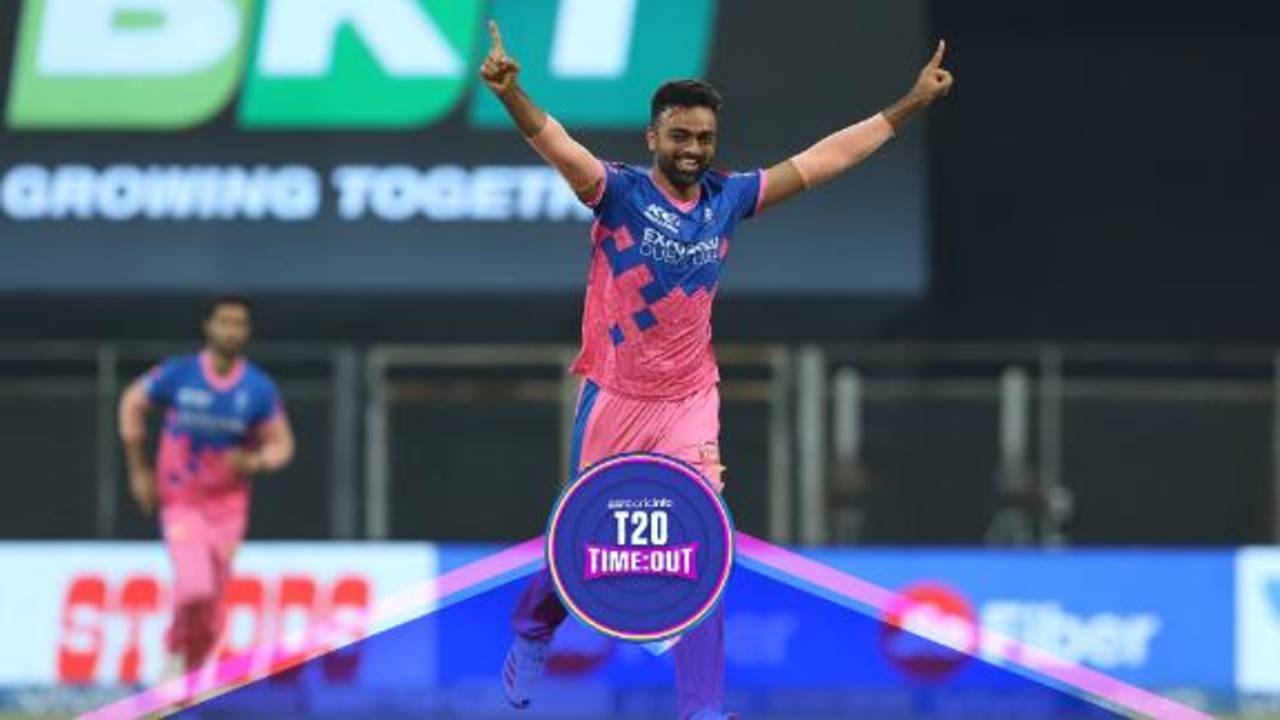How the Royals throttled the Capitals 'slowly'
Prithvi Shaw went for a premeditated slog but was deceived by a slower delivery (112kph) from
Jaydev Unadkat, and the leading edge went straight to the point fielder. Ajinkya Rahane then stepped out against Unadkat, attempting to loft it over the bowler's head but ended up sending a return catch instead, against a cutter (around 110kph). Marcus Stoinis, too, spooned a simple catch against a ball that was bowled at 115kph by
Mustafizur Rahman.
The Capitals' batters were dumbfounded and ended up playing false shots, falling prey to an excellent plan hatched by the Royals' leadership group, led by their new team director Kumar Sangakkara. The plan, according to Unadkat, was to not give batters that "extra bit of pace".
None of the three Royals left-arm fast seamers - Unadkat,
Chetan Sakariya, and Rahman - crossed the mid-130kph mark, mostly sticking to slower speeds. Such a plan, Unadkat said, was worked out after observing the Capitals' batters playing with "hard hands" in their first match against the Super Kings.
The pitch had enough grass and the conditions favoured the ball to move initially. However, the Royals' bowlers rolled their fingers to deliver the perfect cutters, into the pitch and straight at the batters, denying them pace, length, and width.
Why did Unadkat bowl three overs in the powerplay?
Unadkat ended up being the best bowler for the Royals, picking three wickets in the powerplay including two in two balls. In the process, Unadkat also performed an uncharacteristic role of delivering three overs in the powerplay. The only other instance when Unadkat had bowled three with the field restrictions in place was in 2011, when he was representing the Kolkata Knight Riders. On Thursday, Unadkat ended up bowling his four overs inside the first half of the Capitals' innings, the first time in his IPL career.
Unadkat is accustomed to bowling in all three segments of the innings, including at the death where his ability to vary pace has traditionally earned him wickets, especially in IPL 2017 when he played for the Rising Pune Supergiants.
So, why was Unadkat bowled out early? Mainly because of two reasons. One, the Royals have two established death-overs specialists in Chris Morris and Rahman, as well as emerging uncapped Indian left-arm seamer Sakariya. The second likely reason could be Unadkat's match-up against Rishabh Pant: 38 runs, 21 balls, for two wickets before Thursday's game.
Also, in the last three editions, where he has played for the Royals, Unadkat proved to be most expensive at death with an economy rate of 12.77. In contrast, he has started well with the new ball with an economy rate of 8.54.
The powerless powerplays
Both the teams struggled in their powerplays. The Royals were 26 for 3 which is the lowest score so far this IPL in that phase. This was also their worst batting performance in the first six overs since IPL 2013. The Capitals were not too far ahead at 36 for 3 in their first six. Overall, there were a whopping 42 dot balls - that is seven overs out of the 12 powerplay overs between the two teams.
As per ESPNcricinfo's data, this was only the fifth instance (out of 76 matches) of bowlers taking six or more wickets inside the powerplays in the IPL at the Wankhede Stadium. It was also the first time this season no six was hit during the powerplays, a phase in which batters are meant to dominate.
The reasons were pretty simple to work out: both teams' top-order batters paid the price for wrong shot selection against some expert, albeit contrasting, bowling plans. Ultimately the first six overs turned out to be the defining phase as, barring David Miller and Pant, the rest of the batters struggled for fluency.
Why did Pant not give Ashwin his fourth over?
In general, Pant handled his bowlers, and the bowling plans, nicely while trying to defend a low total. After ten overs, the Royals were 52 for 5 with the asking rate nearing the double digits. However, the momentum turned a few overs later when David Miller blasted both Marcus Stoinis and Tom Curran in the 13th and 14th over respectively to pick up 27 runs. Stoinis, who leaked 15 runs, delivered just that one over. Was it necessary to bowl him? Because
R Ashwin still had one over left. He had recovered brilliantly from a forgettable outing against the Super Kings in the first match. Today, he had tied up the Royals' middle order, giving away just 14 runs from his first three overs. On reflection, Pant might regret that decision to not have bowled out his senior-most bowler.
Nagraj Gollapudi is news editor at ESPNcricinfo


